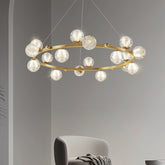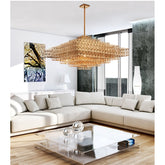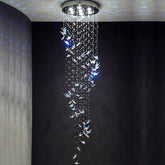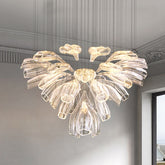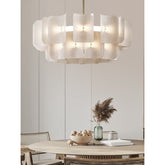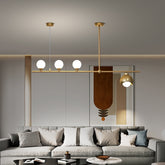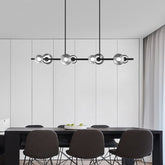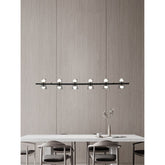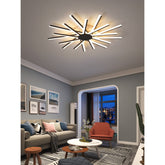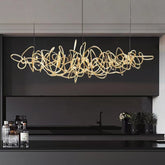Techniques for Theatrical Home Interiors - Creating Drama with Lighting
Understanding the Basics of Theatrical Lighting
Theatrical lighting refers to the strategic use of light to enhance the visual experience in theater productions. Originating from the need to illuminate stages for performances, theatrical lighting has evolved into a sophisticated art form that plays a crucial role in storytelling. In theater, lighting is used to set the mood, highlight key moments, create visual focus, and convey emotions, all while supporting the narrative flow of the production.
The importance of theatrical lighting extends beyond the stage. In home interiors, applying principles of theatrical lighting can dramatically alter the ambiance and functionality of a space. By manipulating light, homeowners can create a variety of atmospheres, from cozy and intimate to bold and dynamic. This transformation not only enhances the aesthetic appeal of a room but also influences the way it is perceived and experienced.
Principles of Theatrical Lighting
To effectively use theatrical lighting in home interiors, it's essential to understand its key principles.
-
Contrast: Contrast is about creating differences in light intensity and color to define spaces and objects. High contrast can draw attention to specific areas or features, making them stand out, while low contrast can blend elements together for a more subdued look. In a living room, for example, a spotlight on a piece of art creates a focal point, whereas ambient lighting provides a soft, even glow that ties the room together.
-
Color: Color in lighting is a powerful tool that can evoke emotions and set the tone of a space. Warm colors like reds, oranges, and yellows create a cozy, inviting atmosphere, while cool colors like blues and greens bring a sense of calm and tranquility. The use of colored lighting can also highlight different times of day or complement the room's decor. Smart lighting systems now allow homeowners to change the color of their lights at the touch of a button, offering endless possibilities for mood enhancement.
-
Intensity: The intensity of light affects the brightness and clarity of a space. High-intensity lighting is useful for areas requiring detailed work, such as kitchens or home offices, whereas low-intensity lighting is ideal for creating relaxing environments, like bedrooms or living rooms. Dimmer switches are a practical solution for adjusting light intensity to suit different activities and times of day.
-
Direction: The direction from which light is cast can significantly influence the appearance of a room. Uplighting can make a space feel larger by illuminating the ceiling, while downlighting creates a more intimate atmosphere by focusing light downward. Side lighting can add drama by creating shadows and highlighting textures. Understanding and controlling the direction of light helps in sculpting the space and highlighting architectural features.
Types of Lighting for Dramatic Effects
Ambient Lighting
Ambient lighting, also known as general lighting, provides overall illumination to a room, ensuring it is well-lit and functional. This type of lighting serves as the foundation upon which other lighting layers are added.
Examples: Ceiling-mounted fixtures, recessed lights, wall sconces, and floor lamps.
Using Ambient Lighting to Create a Base Layer of Illumination
Even Distribution: Ensure ambient lighting is evenly distributed to avoid dark spots and create a balanced atmosphere. This can be achieved with strategically placed ceiling lights or a combination of floor and table lamps.
Dimmer Switches: Incorporate dimmer switches to adjust the light intensity, allowing for different moods and activities.
Ceiling Reflectors: Use light-colored ceilings to reflect light and enhance the overall brightness of the room.
Task Lighting
Task lighting focuses on specific areas where detailed activities take place, providing adequate light to perform tasks comfortably and efficiently.
Purpose: To reduce eye strain and increase visibility for activities like reading, cooking, or working.
-
Examples of Task Lighting in Home Interiors:
- Reading Nooks: Adjustable floor or table lamps with focused beams.
- Kitchen Countertops: Under-cabinet lighting to illuminate work surfaces.
- Home Offices: Desk lamps with adjustable arms and heads for targeted lighting.
Accent Lighting
Accent lighting is used to draw attention to particular objects or features within a room, such as artwork, sculptures, or architectural details. It creates visual interest and depth by highlighting these elements against the ambient lighting background.
- Role: To add drama and focus, enhancing the room's aesthetic appeal.
-
Examples and Placement Tips:
- Artwork: Use picture lights or track lighting to illuminate paintings and sculptures.
- Architectural Features: Recessed or wall-mounted spotlights can highlight fireplaces, textured walls, or alcoves.
- Placement Tips: Position accent lights at a 30-degree angle from the object to avoid glare and create the perfect highlight.
Decorative Lighting
-
Chandeliers, Sconces, and Pendant Lights as Focal Points: Decorative lighting fixtures serve a dual purpose: providing illumination and acting as design elements that enhance the room's decor. They often serve as focal points, adding style and personality to the space.
- Chandeliers: Ideal for dining rooms, living rooms, and entryways, chandeliers add elegance and grandeur.
- Sconces: Wall sconces can flank mirrors, artwork, or doorways, adding symmetry and decorative flair.
- Pendant Lights: Perfect for kitchen islands, dining tables, and hallways, pendant lights offer both functional and aesthetic benefits.
-
The Impact of Decorative Lighting on Overall Interior Design:
- Aesthetic Enhancement: Decorative lights can complement the room’s style, whether it’s modern, traditional, or eclectic, by adding visual interest and character.
- Mood Setting: These fixtures can also set the tone and ambiance, from the romantic glow of a chandelier to the contemporary edge of sleek pendant lights.
- Space Definition: Decorative lighting can help define different areas within an open-plan space, creating a sense of structure and flow.
Techniques for Creating Drama with Lighting
Layered Lighting
Layered lighting involves using multiple light sources at different levels to create a balanced and visually engaging environment. By combining ambient, task, accent, and decorative lighting, you can add depth, texture, and interest to a room, making it more dynamic and adaptable to various activities and moods.-
Practical Steps to Achieve Layered Lighting in Various Rooms:
- Living Room: Start with ambient lighting from ceiling fixtures or recessed lights. Add task lighting with floor lamps next to seating areas for reading. Incorporate accent lighting with wall sconces or spotlights to highlight artwork or architectural features. Finish with decorative lighting, such as a statement chandelier or pendant lights.
- Kitchen: Use ambient lighting from overhead fixtures. Task lighting can be achieved with under-cabinet lights to illuminate countertops. Accent lighting can highlight open shelving or glass-front cabinets. Decorative pendant lights over the island add a stylish focal point.
- Bedroom: Combine ambient lighting with a ceiling fixture or recessed lights. Task lighting can include bedside table lamps or wall-mounted reading lights. Use accent lighting to highlight artwork or create a soft glow behind the headboard. Decorative lighting, such as a chandelier or pendant lights, can add elegance and charm.
Using Shadows and Silhouettes
Shadows create contrast and depth, adding an element of intrigue and drama to a space. They can highlight textures, emphasize shapes, and create a sense of movement.-
Tips for Positioning Lights to Create Intriguing Silhouettes:
- Behind Objects: Position lights behind objects like plants, sculptures, or furniture to cast interesting shadows on the walls.
- At an Angle: Use angled lighting to create elongated shadows that add depth and drama.
- Low-Level Lighting: Place lights low to the ground to cast upward shadows, enhancing the perception of height and space.
Color and Filters
Colors in lighting can significantly influence mood and atmosphere. Warm colors like reds, oranges, and yellows evoke feelings of warmth and comfort, while cool colors like blues and greens promote calmness and relaxation. Bright, vibrant colors can energize a space, while soft, muted tones can create a soothing environment.-
Using Colored Filters and Smart Lighting Solutions to Change the Atmosphere:
- Colored Filters: Attach colored gels or filters to light fixtures to change the hue of the light. This is an effective way to create a specific mood for events or special occasions.
- Smart Lighting: Use smart bulbs and lighting systems that allow you to change colors and intensity with a smartphone app or voice commands. This flexibility enables you to adjust the atmosphere instantly to suit different activities and times of day.
Dimmer Switches and Lighting Control
Adjustable lighting allows you to control the intensity of light, making it possible to create the perfect ambiance for any occasion. Whether you need bright light for a task or a soft glow for relaxation, dimmer switches provide the versatility needed to achieve the desired effect.-
Technology for Controlling Lighting Intensity and Color Remotely:
- Dimmer Switches: Install dimmer switches to control the brightness of your lights manually. These are particularly useful in living rooms, dining rooms, and bedrooms where lighting needs can vary.
- Smart Lighting Systems: Utilize smart lighting solutions such as Wi-Fi-enabled bulbs and hubs that allow remote control of lighting via smartphone apps or voice assistants like Alexa and Google Assistant. These systems can adjust both the intensity and color of the lights, offering unparalleled flexibility and convenience.
Final Words
Lighting is an incredibly powerful tool in interior design, capable of transforming spaces from ordinary to extraordinary. By experimenting with different lighting techniques, you can create environments that not only illuminate but also inspire, comfort, and captivate. Whether it’s the strategic use of shadows to add depth, the layering of various light sources for a dynamic effect, or the application of colored lights to evoke specific moods, the possibilities are endless. Theatrical lighting techniques offer a creative and impactful way to enhance your home, making each room a unique and dramatic stage for everyday life.












































































































